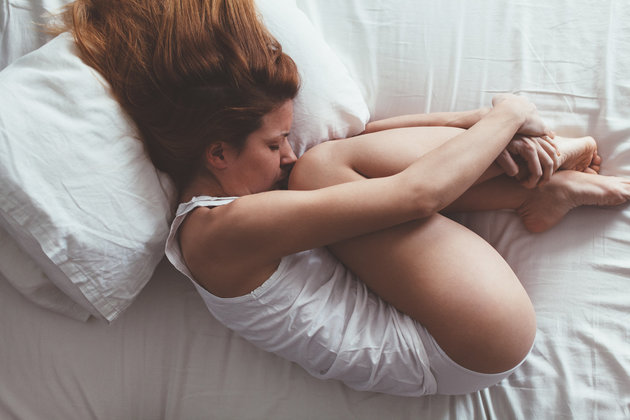When your period hits, the pain varies from a niggling ache to full-on agony in your lower abdomen. Throw menstrual migraines and pre-menstrual cramps into the mix and you’re in for a fun week.
It can be all too easy to reach for the painkillers during this time. But with new studies revealing that routinely taking
non-steroidal anti-inflammatory drugs (NSAIDs), including ibuprofen, could heighten a person’s risk of heart attack, many are keen to find alternatives to help ease the pain.
“People tend to reach for what they know when they are in pain, but there are many alternatives which can offer effective relief from the discomfort of menstruation,”
Hot Water Bottles
Hot water bottles, microwaveable wheat bags and adhesive heated wraps are one way of tackling period pain.
Brian King, from University College London, previously explained the science behind them: “The pain of colic, cystitis and period pain is caused by a temporary reduction in blood flow to, or over-distension of, hollow organs such as the bowel or uterus.”
This causes local tissue damage and activates pain receptors, he said.
“The heat doesn’t just provide comfort and have a placebo effect - it actually deactivates the pain at a molecular level in much the same way as pharmaceutical painkillers work.”
Wearable Tech
“Electrical stimulation devices such as Livia or TENS deliver a mild electrical current to your tummy, which can help reduce pain,” explained Stuart Gale.
Livia is a gadget promising to reduce pain almost immediately by stimulating nerves and blocking the pain from passing to the brain.
Pulse stickers are applied to where pain is felt. Users can then turn the device on and adjust the intensity depending on the level of pain.
Professor Bari Kaplan from Beilinson Women’s Hospital, who is also medical advisor to the Livia production team, said: “Over 50% of women suffer from primary menstrual cramps, for which they consume large amounts of painkillers.
“Livia uses a pain relief method that does not involve drug consumption. The idea is to close the ‘pain gates.’ The device stimulates the nerves, making it impossible for pain to pass.
“The method Livia uses has been proven effective in several clinical studies and I strongly recommend the use of the device to relieve PMS pain at any time.”
Paracetamol
Paracetamol may be used to combat period pain, according to the NHS, but studies suggest it may not be as effective at reducing pain as ibuprofen or aspirin.
Paracetamol is believed to act primarily in the brain, affecting the many different ways we feel pain. According to Panadol, paracetamol “inhibits the production of pain and inflammation-causing chemicals called prostaglandins”. Prostaglandins are found throughout the body, but paracetamol “mainly works on those in the brain”. Because of this it can effectively relieve pain and fever with few side effects when taken at recommended doses.
It’s worth noting that a study from 2015 linked long-term use of paracetamol to an increased risk of gastrointestinal problems, high blood pressure and stroke.
Exercise
According to the NHS, keeping active during your period can reduce pain. It advises trying gentle swimming, walking or cycling.
“Relaxation techniques, such as yoga or pilates, may help distract women from feelings of pain and discomfort,” Dr Vanessa Mackay, spokesperson for the Royal College of Obstetricians and Gynaecologists (RCOG), told HuffPost UK.
A study published in 2016 found that yoga helped alleviate menstrual pain and was associated with an improvement in physical function during that time of the month. It also decreased abdominal swelling, breast tenderness and cold sweats.
“Employers can educate female employees about the benefits of regular exercise such as yoga, which may decrease premenstrual distress and improve female employee health,” the study’s authors wrote.
Warm Baths
“Taking a warm bath or shower can relieve pain and help women relax,” Dr Mackay said.
The hot water acts in a similar way to the application of a hot water bottle, helping to deactivate the pain.

Massage
“A light, circular massage around the lower abdomen can also help reduce pain,” said Dr Mackay.
A study from 2012, published in the Journal of Obstetrics and Gynaecology Research, found that massages - especially ones involving essential oils - helped curb period pain.
Based on the participant’s reports, researchers found that the duration of pain was reduced from 2.4 to 1.8 days after self-massaging with essential oils.
Hot Drinks
“A cup of hot, herbal, ideally caffeine free tea is always a good idea,” explained Stuart Gale.
Cramp bark may be particularly beneficial for people with menstrual cramps, according to the University of Maryland Medical Center. Although people who take diuretics or lithium should ask their doctors before taking it.
Failing that, English Breakfast Tea won’t hurt (just make sure it’s decaf).
Quitting Smoking
“Believe it or not, smoking is thought to increase the risk of period pain, so giving up will help to ease the symptoms – along with bringing a multitude of other physical benefits,” explained Gale.
A study, published in the journal Tobacco Control, found that smokers were more likely to suffer severe menstrual pain than nonsmokers. They also experienced a worsening of pain as the number of cigarettes they smoked per day increased.
Contraceptive Pill
The pill is made of synthetic hormones similar to those found naturally in a woman’s body. It works by preventing the ovary from releasing an egg.
Taking the pill daily can regulate periods and make them lighter. It can also ease period pain.
Dr Mackay explained: “It thins the womb lining, which means the muscles of the womb don’t have to contract as much when it sheds.”













